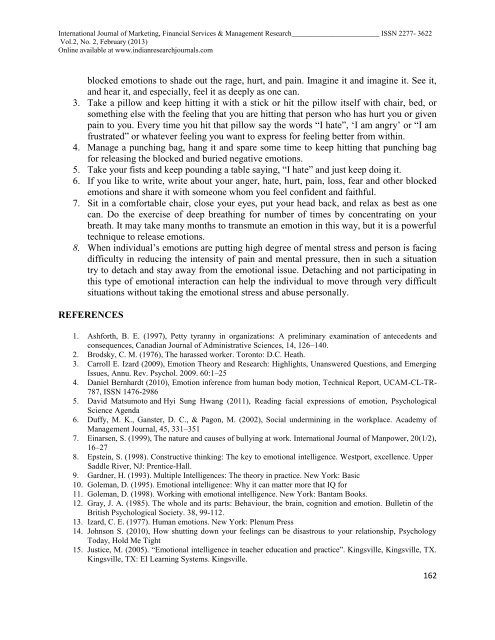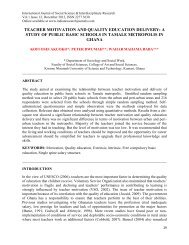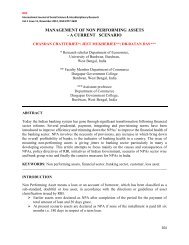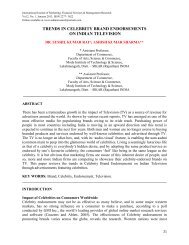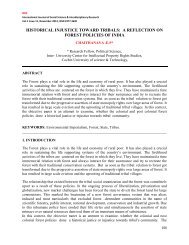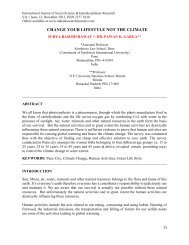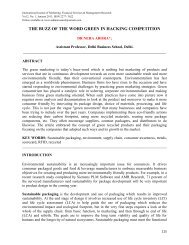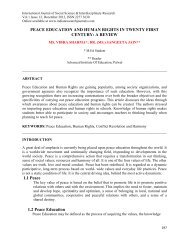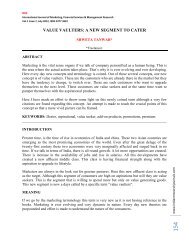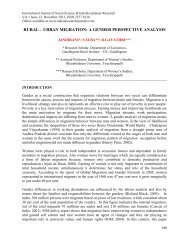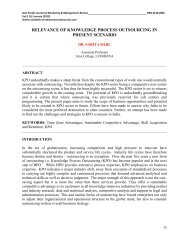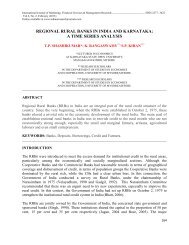blocked emotions - Indianresearchjournals.com
blocked emotions - Indianresearchjournals.com
blocked emotions - Indianresearchjournals.com
Create successful ePaper yourself
Turn your PDF publications into a flip-book with our unique Google optimized e-Paper software.
International Journal of Marketing, Financial Services & Management Research________________________ ISSN 2277- 3622<br />
Vol.2, No. 2, February (2013)<br />
Online available at www.indianresearchjournals.<strong>com</strong><br />
<strong>blocked</strong> <strong>emotions</strong> to shade out the rage, hurt, and pain. Imagine it and imagine it. See it,<br />
and hear it, and especially, feel it as deeply as one can.<br />
3. Take a pillow and keep hitting it with a stick or hit the pillow itself with chair, bed, or<br />
something else with the feeling that you are hitting that person who has hurt you or given<br />
pain to you. Every time you hit that pillow say the words “I hate”, „I am angry‟ or “I am<br />
frustrated” or whatever feeling you want to express for feeling better from within.<br />
4. Manage a punching bag, hang it and spare some time to keep hitting that punching bag<br />
for releasing the <strong>blocked</strong> and buried negative <strong>emotions</strong>.<br />
5. Take your fists and keep pounding a table saying, “I hate” and just keep doing it.<br />
6. If you like to write, write about your anger, hate, hurt, pain, loss, fear and other <strong>blocked</strong><br />
<strong>emotions</strong> and share it with someone whom you feel confident and faithful.<br />
7. Sit in a <strong>com</strong>fortable chair, close your eyes, put your head back, and relax as best as one<br />
can. Do the exercise of deep breathing for number of times by concentrating on your<br />
breath. It may take many months to transmute an emotion in this way, but it is a powerful<br />
technique to release <strong>emotions</strong>.<br />
8. When individual‟s <strong>emotions</strong> are putting high degree of mental stress and person is facing<br />
difficulty in reducing the intensity of pain and mental pressure, then in such a situation<br />
try to detach and stay away from the emotional issue. Detaching and not participating in<br />
this type of emotional interaction can help the individual to move through very difficult<br />
situations without taking the emotional stress and abuse personally.<br />
REFERENCES<br />
1. Ashforth, B. E. (1997), Petty tyranny in organizations: A preliminary examination of antecedents and<br />
consequences, Canadian Journal of Administrative Sciences, 14, 126–140.<br />
2. Brodsky, C. M. (1976), The harassed worker. Toronto: D.C. Heath.<br />
3. Carroll E. Izard (2009), Emotion Theory and Research: Highlights, Unanswered Questions, and Emerging<br />
Issues, Annu. Rev. Psychol. 2009. 60:1–25<br />
4. Daniel Bernhardt (2010), Emotion inference from human body motion, Technical Report, UCAM-CL-TR-<br />
787, ISSN 1476-2986<br />
5. David Matsumoto and Hyi Sung Hwang (2011), Reading facial expressions of emotion, Psychological<br />
Science Agenda<br />
6. Duffy, M. K., Ganster, D. C., & Pagon, M. (2002), Social undermining in the workplace. Academy of<br />
Management Journal, 45, 331–351<br />
7. Einarsen, S. (1999), The nature and causes of bullying at work. International Journal of Manpower, 20(1/2),<br />
16–27<br />
8. Epstein, S. (1998). Constructive thinking: The key to emotional intelligence. Westport, excellence. Upper<br />
Saddle River, NJ: Prentice-Hall.<br />
9. Gardner, H. (1993). Multiple Intelligences: The theory in practice. New York: Basic<br />
10. Goleman, D. (1995). Emotional intelligence: Why it can matter more that IQ for<br />
11. Goleman, D. (1998). Working with emotional intelligence. New York: Bantam Books.<br />
12. Gray, J. A. (1985). The whole and its parts: Behaviour, the brain, cognition and emotion. Bulletin of the<br />
British Psychological Society. 38, 99-112.<br />
13. Izard, C. E. (1977). Human <strong>emotions</strong>. New York: Plenum Press<br />
14. Johnson S. (2010), How shutting down your feelings can be disastrous to your relationship, Psychology<br />
Today, Hold Me Tight<br />
15. Justice, M. (2005). “Emotional intelligence in teacher education and practice”. Kingsville, Kingsville, TX.<br />
Kingsville, TX: EI Learning Systems. Kingsville.<br />
162


